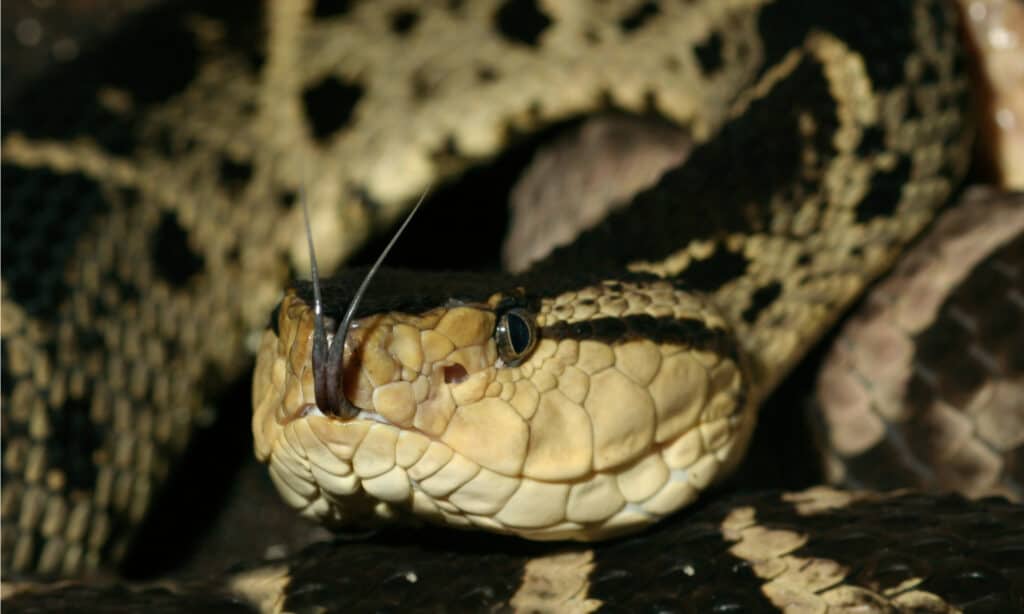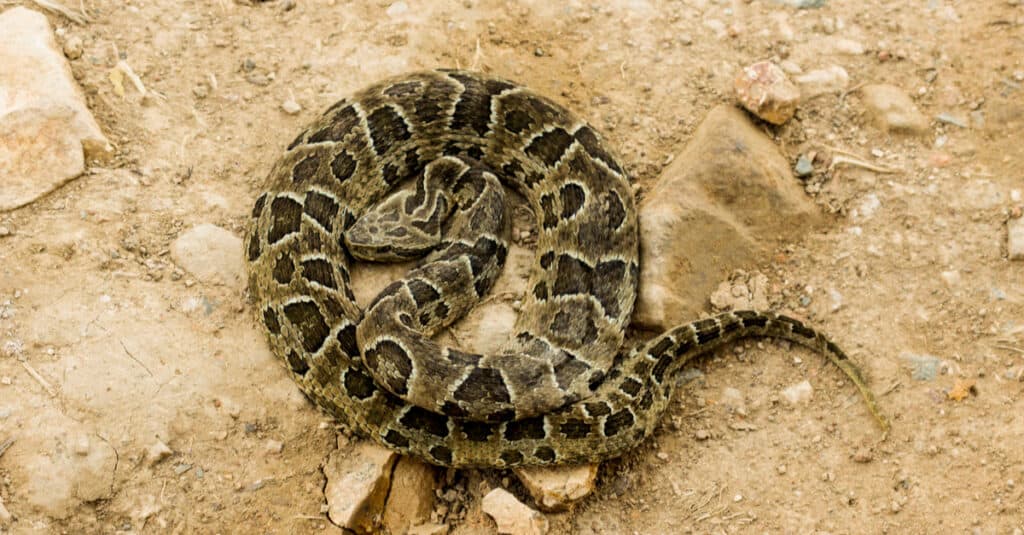More commonly known as the fer-de-lance, the terciopelo bite is potent and powerful enough to kill 6 fully grown people. One of the largest pit vipers known to man, this snake is particularly dangerous for a number of reasons, including its potent and powerful bite. But why is the bite of this snake so powerful, and how does it compare to other venomous snake species?
In this article, we will take an in-depth look at the bite of the terciopelo or fer-de-lance, including how much venom is contained in a single bite. We will also go over whether or not these snakes bite repeatedly, the animals that they typically hunt, and how these snakes interact with humans. Let’s get started and talk about this dangerous snake in more detail now!
Why is the Terciopelo Bite So Powerful?

One of the primary reasons why the fer-de-lance bite is so powerful is because of the sheer size of this snake.
©Mark_Kostich/Shutterstock.com
One of the primary reasons why the fer-de-lance bite is so powerful is because of the sheer size of this snake. The terciopelo reaches 4-6 feet in length and weighs 10-15 pounds on average. Additionally, the length of their fangs and the venom amount per bite is very potent, leading to a painful and potentially lethal wound if left untreated.
Not only that, but the terciopelo exhibits a variety of defensive and aggressive behavior when cornered or threatened. While all venomous snakes prefer to be left alone, and the fer-de-lance is no exception, many people observe inconsistent or erratic behavior with this snake in particular. This leads to unexpected bites, especially in moments when it looks as if the terciopelo is fleeing, but suddenly turns on its perceived threat!
Now that you have a brief overview of why the terciopelo bite is so dangerous, let’s take a look at just how much venom is in a single bite.
How Much Venom Does a Terciopelo Bite Have?

A single fer-de-lance or terciopelo bite contains anywhere from 400 mg of venom all the way to 1500 mg or more.
©Jim Cumming/Shutterstock.com
A single fer-de-lance or terciopelo bite contains anywhere from 400 mg of venom all the way to 1500 mg or more. To put this into perspective, the king cobra bites with roughly 1000 mg of venom maximum per bite. This means that the terciopelo bites with more venom than most other venomous snakes, including the black mamba and the king cobra.
However, the potency of this venom isn’t nearly as deadly compared to other venomous snakes. Not to say that the fer-de-lance isn’t extremely dangerous- in fact, it is responsible for the majority of snakebites and snakebite deaths in its region! When it comes to the potency, there are a few figures that we should take a closer look at.
The lethal dose of venom when used against mice averages just shy of 3 mg. This means that the average person needs a much higher dose than this. Comparing the fer-de-lance with the king cobra, the lethal dose of king cobra venom for mice is only 1 mg. This means that the terciopelo’s venom is not nearly as potent as other snake species. However, given the huge amount that it injects in a single bite, it still has the power to kill 6 humans!
Do Terciopelos Bite Repeatedly?

Given the elaborate defensive displays of this particular snake, it is extremely likely that the fer-de-lance bites repeatedly.
©David Havel/Shutterstock.com
One interesting question to consider with terciopelos is whether or not they bite repeatedly. Given the fact that fer-de-lances exhibit a variety of unpredictable and aggressive behavior when cornered or threatened, it is entirely possible that they bite repeatedly. Studies suggest that the terciopelo lunges forward and bites without being within reach of its threat- a display of warning and defense.
Given the elaborate defensive displays of this particular snake, it is extremely likely that the fer-de-lance bites repeatedly. They rise into the air when cornered, but they prefer to flee more than fight. However, given the unpredictable behavior of this snake, it is extremely likely that they bite their enemies more than once.
What Animals Do Terciopelos Hunt?

Fer-de-lance snakes typically bite their prey and inject it with their potent venom, allowing it to work while the prey escapes.
Terciopelos live in the northeastern portions of Mexico and Central America, as well as South America. They feed on a variety of prey and are considered extremely opportunistic snakes. Juveniles eat a slightly simpler diet compared to adult snakes, but both feed on the following animals:
- Bugs
- Beetles
- Centipedes
- Amphibians such as frogs
- Crayfish
- Eels
- Lizards
- Other snakes
- Birds
- Bird eggs
- Mice
- Rats
- Shrews
- Oppossums
Fer-de-lance snakes typically bite their prey and inject it with their potent venom, allowing it to work while the prey escapes. They then track the prey and feed upon it once the venom has worked. Tracking prey is no easy feat, which is why many juvenile terciopelos only feed on bugs when they are first learning how to hunt.
How Do Terciopelos Interact with Humans?

The majority of recent terciopelo snakebites have been treated with success, and the fatality rates have significantly declined with this particular snake.
©Max Gustavson Filho/Shutterstock.com
Terciopelos are a notoriously dangerous snake given the fact that they live in close proximity to humans and populated areas in South America, Central America, and Mexico. This is one of the reasons why they are responsible for the majority of snake bites in all of these regions. However, like most snakes, they prefer to be left alone and only act aggressively when they are surprised or otherwise threatened.
However, given that the snakes are such opportunistic eaters and tend to behave erratically when they are surprised, terciopelos have received a bad rap. These snakes have a number of defensive positions and maneuvers that they perform when threatened, and they are even capable of spitting venom if necessary. It’s always a good idea to vacate an area that a fer-de-lance is occupying!
How Do You Treat a Terciopelo Snake Bite?
If you happen to be bitten by a fer-de-lance, it is important to seek medical attention immediately. However, the majority of recent terciopelo snakebites have been treated with success, and the fatality rates have significantly declined with this particular snake. This is because of the dedicated research of a variety of herpetological institutions, and a highly effective antivenom has been created.
However, painful symptoms and necrosis can occur within 36 hours of the bite, and most untreated wounds lead to sepsis and death. Just like all venomous snakes, you should always use caution and care if you think you have been bitten by a fer-de-lance!
The photo featured at the top of this post is © Mark_Kostich/Shutterstock.com
Discover the "Monster" Snake 5X Bigger than an Anaconda
Every day A-Z Animals sends out some of the most incredible facts in the world from our free newsletter. Want to discover the 10 most beautiful snakes in the world, a "snake island" where you're never more than 3 feet from danger, or a "monster" snake 5X larger than an anaconda? Then sign up right now and you'll start receiving our daily newsletter absolutely free.
Thank you for reading! Have some feedback for us? Contact the AZ Animals editorial team.







